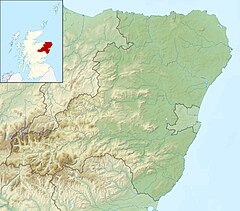Kinnaird Head Lighthouse

Kinnaird Head current lighthouse (left) and the historical (right)
|
|
|
Aberdeenshire
|
|
| Location |
Kinnaird Head Fraserburgh Scotland NJ999676 |
|---|---|
| Coordinates | 57°41′51.8″N 2°0′14.2″W / 57.697722°N 2.003944°WCoordinates: 57°41′51.8″N 2°0′14.2″W / 57.697722°N 2.003944°W |
| Year first constructed | 1787 (first) 1824 (second) |
| Year first lit | 1991 (current) |
| Deactivated | 1991 (second) |
| Construction | stone tower (second) fiber glass (current) |
| Tower shape | cylindrical tower with balcony and lantern rising from a castle (second) cylindrical tower with balcony and lantern (current) |
| Markings / pattern | white tower, black lantern, ochre trim (second) white tower and lantern (current) |
| Height | 22 metres (72 ft) (second) 10 metres (33 ft) (current) |
| Focal height | 25 metres (82 ft) (current) |
| Intensity | 690,000 candela |
| Range | 22 nautical miles (41 km; 25 mi) |
| Characteristic | F. W 5s. |
| Fog signal | siren: discontinued |
| Admiralty number | A3332 |
| NGA number | 2808 |
| ARLHS number | SCO-113 (second) SCO-112 (current) |
| Managing agent |
Museum of Scottish Lighthouses |
|
[]
|
|
Museum of Scottish Lighthouses
The Kinnaird Head Lighthouse is an active lighthouse located on Kinnaird Head, in Fraserburgh, Scotland. The current light is the second to be built on the headland, superseding the original which now forms part of the Museum of Scottish Lighthouses.
The original light at Kinnaird Head Lighthouse was established by Thomas Smith on 1 December 1787. A lantern was set 120 feet (37 m) above the sea on a tower of the old castle. Whale oil lamps produced a fixed light, each backed by a parabolic reflector. Kinnaird Head was the most powerful light of its time, and contained 17 reflectors arranged in 3 horizontal tiers. It was reported to be visible from 12 to 14 miles (10 to 12 nmi; 19 to 23 km).
In 1824, internal alternations were made to construct a new lighthouse tower through the original castle tower. This tower supported a new lantern and reflector array by Robert Stevenson (civil engineer).
In 1851 Robert's son, Alan Stevenson, installed a first order dioptric lens at Kinnaird Head. The lens was standing and gave a fixed character. The site was further improved in 1853 with the site's first purpose built accommodation blocks designed by brothers David and Thomas Stevenson.
David Alan Stevenson further upgraded the site in 1902 by installing a flashing lens apparatus. The hyperradiant fresnel lens gave one flash every fifteen seconds and was visible for 25-27 miles. The lens was designed by David and his brother Charles Alexander Stevenson, and was made by the Chance Brothers. Only nine Scottish lights were given hyperradials, Hyskeir and Kinnaird Head being the only stations to retain their hyperradials today. A foghorn was also built and was operational from 1903 giving a 7-second blast every 90 seconds.
...
Wikipedia

